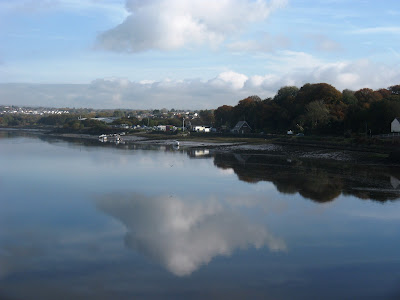This blog may help people explore some of the 'hidden' issues involved in certain media treatments of environmental and scientific issues. Using personal digital images, it's also intended to emphasise seasonal (and other) changes in natural history of the Swansea (South Wales) area. The material should help participants in field-based modules and people generally interested in the natural world. The views are wholly those of the author.
Thursday, 30 November 2023
Vicious!
Environments depend on interactions between their living (biotic) and non-living (abiotic) components. Major changes in one component, has repercussions throughout the 'arrangements'. Humans are far from being independent entities, outside their environments. Phoebe Weston clearly illustrates how the natural world is currently caught in a vicious cycle (https://www.theguardian.com/environment/2023/nov/29/10-ways-in-which-climate-crisis-and-nature-are-linked-aoe). Human-generated 'greenhouse gas' emissions, have intensified global heating. That temperature elevation (which largely started with the burning of fossil fuels in England's Industrial Revolution), has increased the incidence of extreme weather events (like storms, droughts and floods). These events and their consequences (such as wildfires) destroy natural habitats and their associated wildlife. Functioning terrestrial (e.g. forests) and marine (e.g. the deep sea) locations, are crucial 'carbon sinks'. These carbon sinks, store emissions, often for extended periods. Impairing those sinks, allows more climate-changing emissions to remain in the atmosphere. This drives further global heating, increasing the frequency and intensities of extreme weather events. This further destroys natural habitats, making their carbon sinks even less effective and so on, ad infinitum.
Plants We Used To Use 105. Common orache
The plant leaves of Common orache (Atriplex patula) were boiled to produce a yellow/greenish fabric dye. They can also be eaten like spinach or chard.
Plants We Used To Use 104. Common mouse-ear
Like other chickweeds, Common mouse-ear (Cerastium fontanum) leaves can be eaten cooked or raw. Plant extracts have also been used to soothe skin conditions, as well as treating cuts and abrasions.
Climate Change Conference or Carbon Sales Pitch?
Cop28 will be held in Dubai (UAE) chaired by the state oil firm's CEO. Ban Ki-moon and Graca Michel (Deputy Chairs of 'The Elders', a human rights organisation) have appealed for 'world leaders' to use this event to 'get back on track' on limiting anthropogenic (human mediated) climate change. If they fail to do so, they argue, the consequences for humankind will be horrendous (https://www.theguardian.com/commentisfree/2023/nov/30/cop-28-dubai-developing-world-climate-crisis).
Marina Hyde notes, however, that it was distinctly odd to put a state, made rich on petrochemical sales, in charge of humankind's (probable?) last chance to reverse the rise in 'greenhouse gas' emissions (https://www.theguardian.com/commentisfree/2023/nov/28/cop28-save-planet-oil-uae-telegraph). That decision looks even odder, with the revelation that Cop28's chair is intending to use the gathering to 'privately' discuss new sales of fossil fuels. Fiddling, whilst the planet burns?
Wednesday, 29 November 2023
Plants We Used To Use 103. Common milkwort
Common milkwort (Polygala vulgaris) leaves are used as a tea substitute. Its root extracts have been used to treat insomnia, anxiety, excessive brooding etc.
Guilt-Free Flying?
There's been a great fanfare for Virgin Atlantic's flight VS100. This flight was partly funded by the UK government. Its being hailed as the first transatlantic flight using '100% sustainable jet fuel' and a means of producing 'guilt-free flying' (https://www.theguardian.com/business/2023/nov/28/transatlantic-flight-sustainable-jet-fuel-virgin-atlantic-saf). Flight VS100 used cooking oil as fuel, rather than kerosene, cutting down on fossil fuels. So-called 'Sustainable Aviation Fuel' (SAF) is attractive to airlines as it requires minimal modification of existing aircraft. It has, however, some problems. Firstly, SAF's current availability is less than 0.1% that of kerosene. Secondly, its production competes with that of agricultural food production. Agricultural land is declining, as the world human population increases and climate change exerts its pressures. Thirdly, SAF is still carbon dioxide in: carbon dioxide out. Fourthly its use still generates contrails high in the atmosphere thatincrease global heating. Finally, using SAF reduces incentives to radically change flight technologies. We are a long way from 'guilt-free flying'!
Plants We Used To Use 102. Common mallow
Although Common mallow (Malva sylvestris) is edible, it's fairly tasteless. Its leaves, however, can be used to make a poultice or used as a tea/gargle for sore throats.
Plants We Used To Use 101. Common knapweed
Common knapweed (Centaurea nigra) flowers (but not the tough bracts) can be added to salads. The Welsh Physicians of Myddfai added the plant as an ingredient to potions to counter Adder (the only poisonous snake in the country) bites.
Tuesday, 28 November 2023
Himalayan Hazards
Road-building in India's Himalayan regions has to be untaken with extreme care. This location is very prone to landslides and earthquakes. The Silkyara-Barkot tunnel was just one component of the $1.5bn, 550 mile, Char Dham highway project, linking four Hindu pilgrimage sites. The tunnel's collapse, trapped 41 labourers for 17 days (https://www.theguardian.com/world/2023/nov/28/indian-rescuers-reach-41-men-trapped-in-tunnel). The Silkyara-Barkot tunnel had no emergency exit and was built through a geological fault. Very fortunately, the trapped labourers were able to be supplied with oxygen, food, water and medications through a small water pipe surviving the collapse of the tunnel's roof. It seems likely that a landslide caused the collapse. The labourers were eventually rescued by a combination of hi-tech (drilling machines) and low-tech (a team using banned 'rat-hole mining). India's National Highways Authority has now been instructed to audit 29 other tunnels. Even grandiose schemes in the Himalayas need to take geology into account.
Don't Make a Pig's Ear of the Response!
Swine 'flu only rarely infects humans. World-wide, some 50 human cases of the type H1N2 strain have been recorded. The UK, however, has just had its first human case, involving a clade (1b1.1) that's distinct from other recent cases (https://www.theguardian.com/world/2023/nov/27/uk-detects-first-human-case-swine-flu-strain-h1n2). The patient's symptoms are reported to be mild. The World Health Organisation has, however, been informed and folk are attempting to trace his contacts. This isn't a zoonotic disease that should circulate uncontrolled. Viruses do change and can jump to new hosts with severe consequences.
Plants We Used To Use 100. Common hogweed
Common hogweed (Heracleum spondylium) has been used in herbal medicine, as an aphrodisiac etc. The plant's dried seeds (use gloves, if they're green) can be used in baking, infused in gin, rum or brandy and added as a mulled cider spice. They can even be an alternative to cardamon/coriander in curries.
Plants We Used To Use 99. Common hemp nettle
Common hemp nettle (Galiopsis tetrahit) is poisonous but has been used in traditional medicine as a diuretic, expectorant and laxative.
Subscribe to:
Comments (Atom)
-
I n the UK and US, a pparently popular and successful vegan/vegetarian restaurants are reportedly closing or adding meat to their menus ( ...
-
Early ripening fruit may seem convenient but some folk think it confirms environmental stress. There's also a possibility th...









































































%20mating%20NWCW.jpg)

